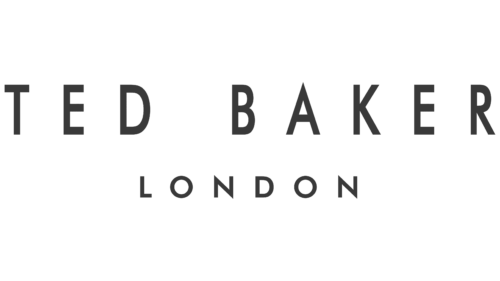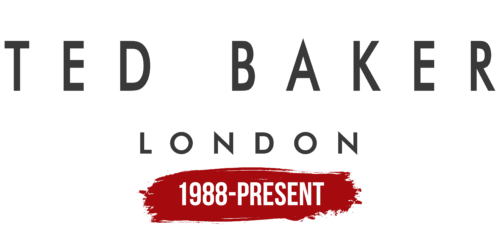The Ted Baker London logo embodies an atmosphere of calm, respectability, and harmony. Each line conveys the idea of high fashion, emphasizing the sophistication and elegance inherent to the brand. The symbols used in the emblem appear confident and highlight independence, reflecting the key characteristics of the brand’s products. This visual element helps create distinctive looks that stand out for their uniqueness and style. The visual mark is an aesthetic that brings balance and style to the lives of its customers.
Ted Baker London: Brand overview
The history of Ted Baker began in 1988 when Ray Kelvin opened his first store in Glasgow, Scotland. After working in a family-owned clothing business, Kelvin started his brand, focusing on high standards, attention to detail, and a uniquely British sense of humor.
The original store sold only men’s shirts. Kelvin chose “Ted Baker” because it sounded British and trustworthy. Interestingly, he preferred to remain behind the scenes, never using his name publicly or appearing in promotional photos.
From the beginning, the brand stood out due to its unconventional marketing. Kelvin relied on word-of-mouth and product quality instead of traditional advertising. He also employed creative strategies, like offering customers free shirt laundering and pressing.
In 1990, the company expanded its product line to include women’s clothing, broadening its customer base and fueling its growth.
A major turning point came in 1993 when the brand opened its first store on King’s Road in London. This move helped attract a wider audience and solidify its position in British fashion.
In 1995, the label introduced its first line of accessories, including eyewear, watches, and fragrances. This expansion helped it evolve into a lifestyle company, offering a wide range of products.
A significant moment in the company’s history occurred in 1997 when it went public on the London Stock Exchange. The IPO provided additional resources for growth and development.
International expansion began in 1998 when the first store outside the UK opened in New York. This marked the start of global distribution.
The 2000s were a period of rapid growth. The company launched its first website in 2000, entering the e-commerce market. That same year, it opened its first store in Asia, in Hong Kong.
In 2004, the brand expanded into interior design with the launch of its home goods collection, focusing on lifestyle products.
The introduction of a footwear line in 2006 allowed the company to offer a complete style package, including clothing and shoes.
A key moment came in 2011, when a flagship store on Fifth Avenue in New York opened, solidifying the company’s presence in the US market.
In 2012, global growth continued with stores opening in Beijing, China, and Toronto, Canada.
In 2015, the company launched a grooming line offering men’s skincare and hair care products. The brand saw a significant increase in online sales by 2017, aligning with the broader retail trend toward digitalization.
However, the company faced serious challenges in 2018 when CEO and founder Ray Kelvin was accused of inappropriate behavior at work. Following an investigation, Kelvin resigned in March 2019.
The year 2019 brought further difficulties, as financial problems and accounting irregularities surfaced after Kelvin’s departure, leading to a drop in share prices and a strategic review.
Despite global challenges in 2020, the business adapted by focusing on online sales and streamlining its retail operations.
In 2021, the company focused on restructuring and stabilizing its finances, launching a new strategy to build on its strengths and adapt to changing market demands.
By 2023, the company remained a well-known British brand with a global presence. Despite recent challenges, the label retained its distinct identity, rooted in British style, quality, and attention to detail. From its beginnings as a small men’s shirt shop in Glasgow, the company grew into a global lifestyle brand. Over the years, it has experienced rapid growth, international expansion, and product innovation while facing significant setbacks. However, the brand has managed to maintain its reputation and loyal customer base, continuing to represent a distinctively British sense of humor and style.
Meaning and History
What is Ted Baker London?
This British luxury clothing retailer is known for its unique aesthetic, high craftsmanship, and attention to detail. The company offers various products, including home goods, accessories, and clothing for men and women, each distinguished by original and elegant designs. The brand is renowned for its unconventional approach to design, combining humorous and eccentric elements with traditional motifs. Bold patterns, rich colors, and whimsical details make the company’s products easily recognizable among other luxury brands. Despite global success, the brand maintains its distinctly British identity in design and marketing strategy.
1988 – today
The Ted Baker logo consists of its name, which includes the name of a fictional character and the city where its headquarters is located. The name “Ted Baker” does not belong to a real person but to a character created by the founder. This character embodied the kind of man the founder aspired to be: bold and masculine. This fictional persona flew planes, played sports, attracted women’s attention, and even married the most famous among them. He represented everything that could make him the perfect alter ego.
The word “London” in the emblem is written in a smaller font and positioned below the main name, indicating that the brand did not intend to limit itself to England. It was a hint at ambitions and a drive for future global recognition. Interestingly, the first store was opened in Glasgow, not London. The brand only reached the capital two years after its launch. However, including London in the name from the beginning signaled the founder Ray Kelvin’s large-scale ambitions, who aimed at the international stage from the outset.
The font features evenly spaced, vertically elongated gray letters with increased spacing between the characters. Each letter looks like a separate element, conveying a sense of confidence and exclusivity, which was associated with the company’s products, considered elite. The pointed ends of the letters, stretching upward, symbolized the brand’s aspiration to the top. This aspiration was reflected in the company’s rapid development, which expanded its products to other countries, fulfilling Ray Kelvin’s ambitions. Over three decades, Ted Baker opened more than 500 stores worldwide, embodying these intentions.
Two thousand twenty-four, the brand was declared bankrupt, and Ted Baker stores were closed. However, the company’s products remain available through other retail networks, allowing its legacy to continue.





